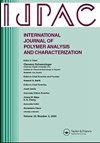性能增强的 NASICON 掺杂固体聚合物电解质
IF 1.7
4区 工程技术
Q4 POLYMER SCIENCE
International Journal of Polymer Analysis and Characterization
Pub Date : 2024-10-02
DOI:10.1080/1023666X.2024.2383460
引用次数: 0
摘要
本研究采用掺杂 Zr (LAZTP) 和 Nb (LANbTP) 的 LATP 作为陶瓷填料,以聚丙烯腈 (PAN) 作为主聚合物,通过溶液浇铸法合成了一种新型的 "掺杂陶瓷-聚合物复合材料 "型固体聚合物电解质 (SPE)。我们使用 XRD、SEM 和阻抗分析法研究了一系列具有不同陶瓷负载量(10、20、30、40 和 80 重量百分比)的 SPE。XRD 光谱显示,在复合固体聚合物电解质中存在结晶陶瓷峰。此外,SEM 图像也证实了填料的均匀分布。对于 SPE,PAN + LANbTP30 在室温下的最高电导率为 5.31 × 10-5 S cm-1。而加入 LATP 的 PAN 的最佳电导率为 1.79 × 10-5 S cm-1,加入 LAZTP 的样品在室温下的电导率为 3.03 × 10-5 S cm-1。此外,与纯 PAN 相比,含有 LANbTP 的 SPE 显示出 4.90 V 的出色电压稳定性。本文章由计算机程序翻译,如有差异,请以英文原文为准。
Enhanced performance in a NASICON-incorporated solid polymer electrolyte
In the present work, a novel ‘doped ceramic-polymer composite’-based solid polymer electrolytes (SPEs) has been synthesized using Zr (LAZTP) and Nb (LANbTP)-doped LATP as a ceramic filler and polyacrylonitrile (PAN) as a host polymer via the solution cast method. A series of SPEs with different ceramic loadings ranging from 10, 20, 30, 40, and 80 wt. % have been investigated using XRD, SEM, and impedance analysis. XRD spectra show the presence of crystalline ceramic peaks in composite solid polymer electrolyte. Further, the homogeneous distribution of the filler has been confirmed by SEM images. For SPEs, the highest conductivity of 5.31 × 10−5 S cm−1 has been obtained for PAN + LANbTP30 at room temperature. Whereas, the optimized conductivity for LATP-incorporated PAN shows 1.79 × 10−5 S cm−1, and the LAZTP-incorporated sample shows a conductivity of 3.03 × 10−5 S cm−1 at room temperature. Also, LANbTP-contained SPE shows excellent voltage stability of 4.90 V w.r.t. pure PAN.
求助全文
通过发布文献求助,成功后即可免费获取论文全文。
去求助
来源期刊
CiteScore
3.50
自引率
5.30%
发文量
37
审稿时长
1.6 months
期刊介绍:
The scope of the journal is to publish original contributions and reviews on studies, methodologies, instrumentation, and applications involving the analysis and characterization of polymers and polymeric-based materials, including synthetic polymers, blends, composites, fibers, coatings, supramolecular structures, polysaccharides, and biopolymers. The Journal will accept papers and review articles on the following topics and research areas involving fundamental and applied studies of polymer analysis and characterization:
Characterization and analysis of new and existing polymers and polymeric-based materials.
Design and evaluation of analytical instrumentation and physical testing equipment.
Determination of molecular weight, size, conformation, branching, cross-linking, chemical structure, and sequence distribution.
Using separation, spectroscopic, and scattering techniques.
Surface characterization of polymeric materials.
Measurement of solution and bulk properties and behavior of polymers.
Studies involving structure-property-processing relationships, and polymer aging.
Analysis of oligomeric materials.
Analysis of polymer additives and decomposition products.

 求助内容:
求助内容: 应助结果提醒方式:
应助结果提醒方式:


